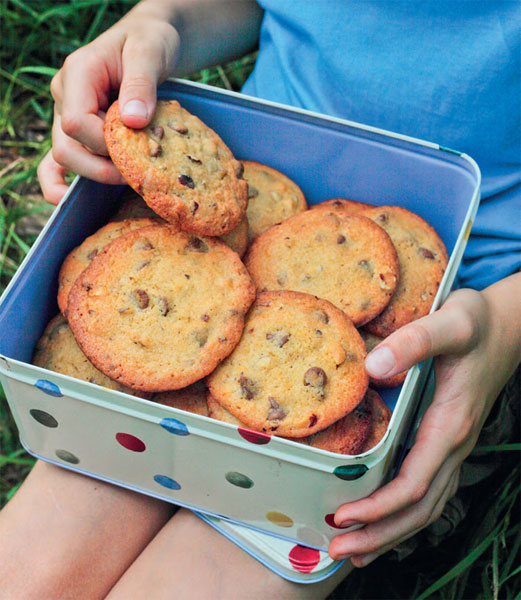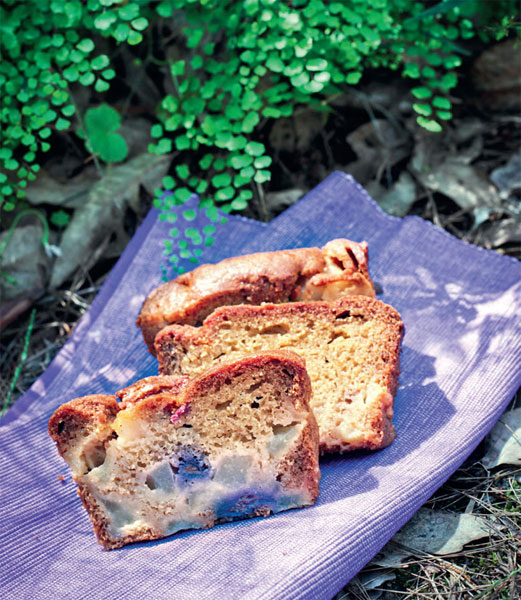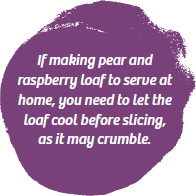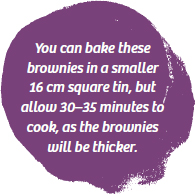

BANANA AND COCONUT BREAD

We nearly always take a loaf of this banana bread with us on camping trips. It’s quick to prepare and there’s always enough to feed a crowd. Any that isn’t eaten on the day you bake it can be toasted briefly in a pan or over the fire and served warm, spread with a little butter.
MAKES 1 loaf
3 ripe bananas, mashed well
2 eggs, lightly beaten
150 g (1 cup) plain flour
100 g desiccated coconut
180 g caster sugar
1 teaspoon salt
1 teaspoon bicarbonate of soda
1 Preheat a fan-forced oven to 180°C (Gas 4). Grease and line the base and sides of a 21 x 11 cm loaf (bar) tin or other similar tin with baking paper.
2 Put the mashed banana in a large bowl and mix in the eggs; it’s quicker if you use electric beaters, but not essential. One by one, beat in the flour, then the coconut, sugar, salt and bicarbonate of soda until combined.
3 Spoon the mixture into the prepared tin and bake for about 50 minutes. If the top starts to brown too much, cover with foil for the remaining cooking time. To ensure the loaf is cooked, stick a skewer into the loaf and leave for 5 seconds before removing – if it comes out dry it is cooked.
4 Remove the bread from the oven and allow to cool in the tin for 5 minutes, before turning out onto a wire rack to cool completely.
5 Serve the banana bread warm or at room temperature, cut into slices.

HOMEMADE FRUIT AND NUT MUESLI SQUARES

Pack a few pieces of this nutritious slice for long car journeys or if you’re going on a hike. They are ideal for hungry tummies after a day at the beach or to break up a lazy afternoon. I suggest making large squares, but they can also be cut smaller for a quick bite if you prefer.
MAKES about 15 pieces
90 g (¼ cup) honey
100 g butter
100 g (½ cup lightly packed) soft brown sugar
200 g (2 cups) rolled oats
40 g (⅓ cup) chopped hazelnuts
40 g (⅓ cup) chopped walnuts or pistachios
120 g (¾ cup) mixed dried fruit, such as raisins, apricots, cranberries, dates and sultanas (golden raisins), larger pieces diced

1 Preheat a fan-forced oven to 170°C (Gas 3). Line a shallow 26 x 17 cm baking tin or other similar tin with baking paper.
2 Put the honey, butter and sugar in a saucepan over low heat. Melt the butter slowly, stirring occasionally to combine. Do not boil. Remove from the heat and stir well.
3 In a separate bowl, combine the oats, nuts and fruit. Add to the honey mixture, stirring well to ensure the dry ingredients are coated. Spoon the mixture into the prepared tin and use the back of a large spoon or spatula to press it down into the edges and smooth the top. Bake for about 30 minutes – the slice should be dark golden.
4 Remove from the oven and leave to cool in the tin for 10 minutes, then cut the slice into about 15 pieces. Leave to cool completely in the tin, then re-cut the slice when cool and store in an airtight container for up to four days.

OAT AND RAISIN COOKIES
These rustic, quick-to-prepare cookies can be baked on the morning of your camping trip or the night before. They can be stored for up to four days in an airtight container, although they may not last that long! This recipe can be doubled to make more if you are cooking for a crowd.
MAKES about 20 cookies
75 g (½ cup) wholemeal flour
150 g (1½ cups) rolled oats
1 teaspoon baking powder
30 g (¼ cup) chopped hazelnuts or walnuts
80 g (½ cup) raisins
60 g butter, at room temperature
115 g (⅓ cup) honey
1 egg, lightly beaten
1 teaspoon natural vanilla extract
1 Combine the flour, oats, baking powder, nuts and raisins in a large bowl.
2 In a separate bowl, beat together the butter, honey, egg and vanilla extract for 1–2 minutes using electric beaters. Using a spoon, stir in the dry ingredients and mix well until thoroughly combined.
3 Transfer the mixture to the refrigerator for 30 minutes to harden slightly. If you are running short of time, you can skip this step, but the cookies will hold their shape and have a better texture if you refrigerate the dough first.
4 Preheat the oven to 170°C (Gas 3). Line two baking trays with baking paper. Using about 1 tablespoon of the mixture at a time, roll into balls, then place onto the prepared trays about 3 cm apart – press down gently on each cookie so they are about 5 mm thick. Bake in the oven for 12–15 minutes, or until lightly golden.
5 Remove the cookies from the oven and leave to cool on the trays for 2 minutes, before transferring to a wire rack to cool completely. Store in an airtight container for up to four days.

WHOLEMEAL BISCUITS
These biscuits are a scrumptious combination of sweet and savoury. The dough freezes well, so unbaked biscuits can be frozen for later use – just cut out and prick the biscuits (but don’t brush with milk), then freeze between layers of baking paper. Brush with milk before baking.
MAKES about 40 biscuits
300 g (2 cups) wholemeal flour
100 g (1 cup) rolled oats
1 teaspoon baking powder
1 teaspoon salt
150 g butter, cubed
100 g (½ cup lightly packed) soft brown sugar
1 egg, lightly beaten
milk, for brushing

1 Preheat a fan-forced oven to 170°C (Gas 3). Line two baking trays with baking paper.
2 Sift the flour into a large bowl, returning the husks to the bowl. Transfer to a food processor, then add the oats, baking powder and salt. Pulse briefly to combine. Add the butter and process for about 10 seconds. Alternatively, the dough can be mixed by hand. Rub the butter into the dry ingredients until it resembles fine breadcrumbs.
3 Transfer to a large bowl, stir in the sugar and egg and use your hands to combine to make a firm, stiff dough. Halve the dough and shape into balls, then knead both halves for about 10 seconds, or until just coming together.
4 Roll out half of the dough between sheets of baking paper to about 5 mm thick. Stamp out rounds using a 6 cm or 7 cm round pastry cutter. Carefully transfer the rounds to the prepared trays. Re-roll any trimmings. Repeat with the remaining biscuit dough.
5 Lightly brush the top of each round with milk then prick lightly all over with a fork. Bake the biscuits for 13–15 minutes, or until they have turned a slightly darker colour.
6 Remove the biscuits from the oven and allow to cool on the tray for 5 minutes before transferring to a wire rack to cool completely. Store for up to four days in an airtight container.

CHOCOLATE CHIP COOKIES

These are my absolute favourite cookies. They should be soft and chewy, not hard and crumbly. I often make a large batch and freeze half, so I always have some in the freezer ready to bake when we go camping. Stored in an airtight container they should last up to five days, but they are irresistibly more-ish and for this reason come with a warning!
MAKES about 24 cookies
275 g plain flour
1 teaspoon salt
1 teaspoon baking powder
225 g butter, softened
175 g soft brown sugar
175 g caster sugar
2 eggs, lightly beaten
200 g (1¼ cups) chocolate chips
100 g (¾ cup) mixed nuts, chopped
1 teaspoon natural vanilla extract

1 Sift the flour, salt and baking powder into a large bowl.
2 In a separate bowl, beat together the butter and both sugars with an electric whisk for 4–5 minutes, or until pale and creamy. Gradually beat in the eggs, mixing well after each addition. Don’t worry if the mixture starts to curdle.
3 Slowly add the flour mixture and stir until well combined. Stir in the chocolate chips, nuts and vanilla extract. Leave to chill in the refrigerator for 1–2 hours. Although they can be baked immediately, chilling them gives the cookies a better shape and texture.
4 Preheat a fan-forced oven to 180°C (Gas 4). Line two baking trays with baking paper. Take heaped teaspoons of the cookie mixture at a time and quickly roll into balls, then flatten slightly. Place on the trays about 5 cm apart. Bake for 10–15 minutes, or until golden, but soft.
5 Remove from the oven and leave the cookies to cool on the trays for 5 minutes, before transferring to a wire rack to cool completely. Pack into an airtight container for transporting to camp.

PEAR AND RASPBERRY LOAF

This delicious loaf makes a wonderful healthy snack. It is perfect for serving to hungry kids and adults returning from camp adventures. You can use frozen mixed berries if fresh are unavailable – there is no need to defrost them before using.
MAKES 1 loaf
180 g (1½ cups) self-raising flour
a pinch of salt
½ teaspoon bicarbonate of soda
80 g (⅓ cup firmly packed) soft brown sugar
1 egg, lightly beaten
125 ml (½ cup) vegetable oil
160 ml (⅔ cup) milk
2 ripe pears, peeled, cored and diced
60 g (½ cup) fresh or frozen raspberries

1 Preheat a fan-forced oven to 180°C (Gas 4). Grease and line the base and sides of a 22 x 8 cm loaf (bar) tin or other similar tin with baking paper.
2 Sift the flour into a bowl with the salt and bicarbonate of soda. Add the sugar, crumbling any large lumps.
3 In a separate bowl, beat together the egg, oil and milk. Add to the dry ingredients and mix well. Gently fold through the pear and raspberries until just combined. Do not over-mix.
4 Spoon the mixture into the prepared tin and bake for 60 minutes. If the top starts to brown too much, cover with foil for the remaining cooking time. To ensure the loaf is cooked, stick a skewer into the loaf and leave for 5 seconds before removing if it comes out dry it is cooked.
5 Remove the loaf from the oven and leave to cool in the tin. Wrap in baking paper and store in an airtight container. Cut into slices to serve.

FLAPJACKS
Flapjacks are an endearing memory from my childhood in London. This particular recipe is inspired by the one from my mum’s 1961 Marguerite Patten baking book. These delicious squares of oats held together by butter, golden syrup and sugar are simple to make. They are perfect for munching around the campfire, for taking to the beach, or for a delicious treat at the end of a long walk or bike ride. Prepare a batch before you leave home.
MAKES 16 flapjacks
175 g butter or margarine
85 g demerara sugar
3 tablespoons golden syrup
a pinch of salt
225 g (2¼ cups) quickcooking rolled oats
1 Preheat a fan-forced oven to 180°C (Gas 4). Grease and line the base and sides of a 21 cm square baking tin, or other similar tin with baking paper.
2 Melt the butter in a saucepan over medium heat. Add the sugar, golden syrup and salt and stir to combine. Remove from the heat, add the oats and mix well to combine.
3 Press the flapjack mixture firmly into the prepared tin, smoothing the top. Bake for 25 minutes if you like chewy flapjacks, or for 30 minutes if you prefer them crunchier.
4 Remove from the oven and leave to cool in the tin for 5 minutes, then cut into 16 or 20 pieces. Do not leave for too long or they will harden and be hard to cut. Set the tray aside until completely cool, then re-cut when cool. Remove from the tin and store in an airtight container for up to four days.

CHOCOLATE BROWNIES
These brownies are chewy and delicious – you can choose whether to make them even more decadent by adding chocolate chips, or more ‘adult’ by adding nuts. I often add hazelnuts, but unsalted macadamias are great too. Sometimes I cut these brownies into tiny squares to make them a one-bite treat. It’s easiest to cut them into 16 squares first and then halve each one.
MAKES 16–20 brownies
185 ml (¾ cup) vegetable oil
230 g (1 cup) soft brown sugar
2 eggs, lightly beaten
1 teaspoon natural vanilla extract
100 g (⅔ cup) chocolate chips or walnuts, hazelnuts or unsalted macadamia nuts, chopped
75 g (½ cup) plain flour
¼ teaspoon baking powder
40 g (⅓ cup) unsweetened cocoa powder

1 Preheat a fan-forced oven to 180°C (Gas 4). Grease and line the base and sides of a 21 cm sq uare cake tin. If you don’t have this exact size tin, use a similar one, but bear in mind if your tin is larger, the brownies won’t be quite as moist.
2 Put the oil and sugar in a large bowl and whisk using electric beaters for about 2 minutes until well combined. Add the eggs and vanilla extract and mix until just blended. Stir in the chocolate chips or nuts and distribute evenly.
3 Sift the flour, baking powder and cocoa into the mixture and fold in, but do not over-mix. Pour into the prepared tin and bake for about 20 minutes. To test if the brownies are cooked, insert a skewer into the middle – it should still be a bit gooey but not have any raw mixture on it.
4 Remove from the oven and allow to cool in the tin for 5 minutes, then carefully lift out using the baking paper and transfer to a wire rack to cool completely. Trim the edges (eating them of course), then cut into 16 or 20 pieces. Brownies can be stored in an airtight container for up to four days, but will start to lose their moistness the longer they are kept.